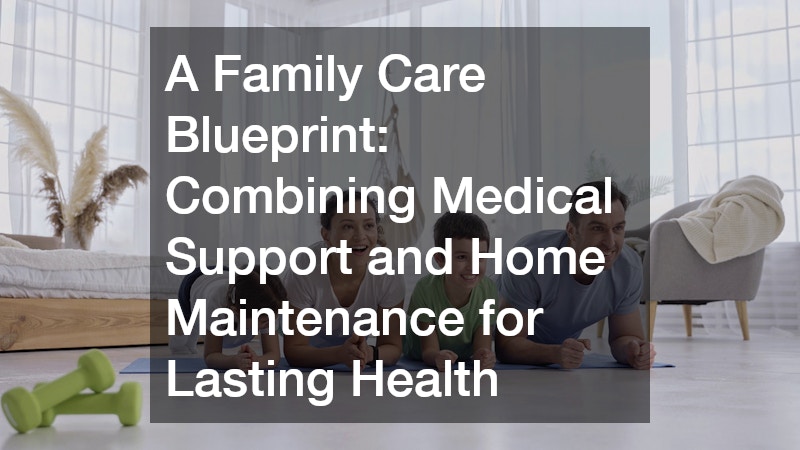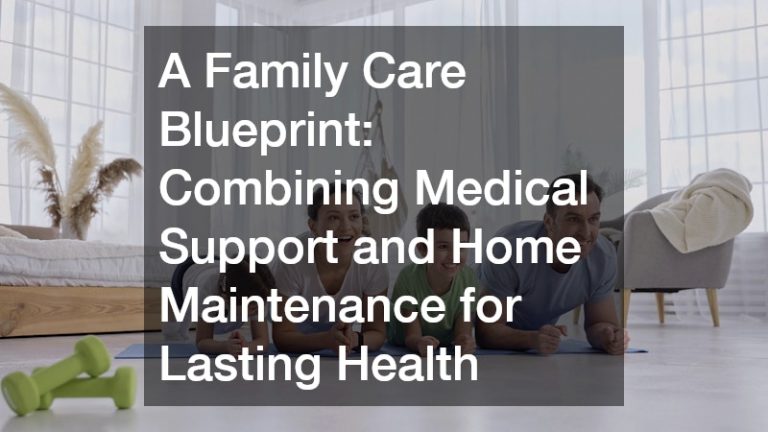A family’s health is more than just the sum of medical appointments and balanced meals—it’s also deeply tied to the environment where they live. A clean, well-maintained home is the first line of defense against illness, allergens, and mental stress. Similarly, regular medical support helps every family member—from children to seniors—stay strong and resilient.
This connection between medical care and home maintenance is often overlooked. Many households focus on one and neglect the other, not realizing how interdependent they are. For instance, clean indoor air can reduce asthma symptoms, while safe water prevents infections. Preventive healthcare and routine home upkeep form a powerful duo that ensures a happy and healthy family.
This article offers a comprehensive family care blueprint—combining medical support, home safety, and maintenance practices to protect your loved ones for the long haul.
The Foundation of Family Wellness: Preventive Medical Care
A. Regular Health Checkups for Every Age Group
Preventive healthcare starts with awareness. Every family member should receive regular checkups, even if they appear healthy. These visits help detect early signs of illnesses that can be treated before they become serious.
For young children, pediatric services play a critical role. Pediatricians monitor growth milestones, provide vaccinations, and guide parents on nutrition, sleep, and emotional health. Early intervention can prevent developmental delays or behavioral challenges from escalating.
Children with disabilities or chronic conditions may need specialized home setups that promote comfort and independence. For example, beds for kids with special needs are designed to ensure safety and better posture, providing the right balance of support and security. Such adjustments can significantly improve a child’s sleep quality and overall health.
B. Oral Health as a Window to Overall Health
Dental care is another cornerstone of family wellness. Many people underestimate how oral hygiene affects the body. Gum disease, for instance, has been linked to heart conditions and infections in other parts of the body. Regular visits to a dentist ensure cavities, infections, and gum issues are managed early.
Encouraging children to establish good brushing and flossing habits is just as important. Parents can make dental routines fun with timers or reward charts, helping kids view oral care as part of daily self-care, not a chore.
C. Elderly Care and Assisted Living Support
As families age, attention must turn toward the comfort and safety of older relatives. Assisted living options—whether in a facility or through in-home care—help seniors maintain independence while receiving the medical and emotional support they need.
For those who choose to age in place, the home environment must be adjusted for mobility and safety. Non-slip floors, grab bars, and good lighting are small changes that prevent accidents. When paired with compassionate medical monitoring, these measures create a dignified and secure space for aging loved ones.
Home Health Starts with Clean Air and Water
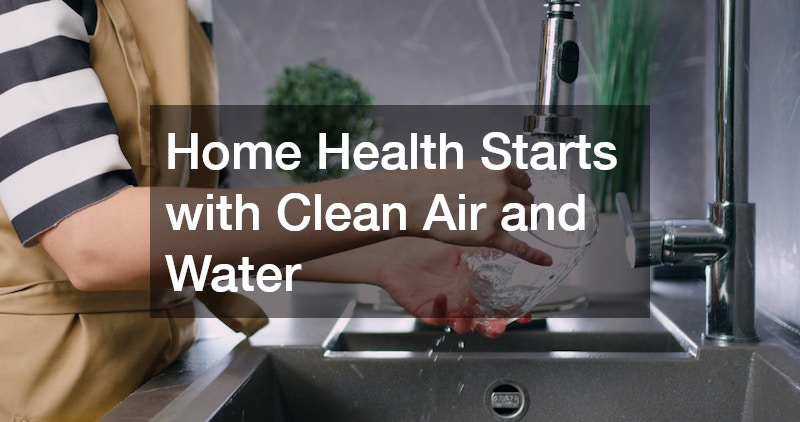
A. Breathing Easy with Reliable HVAC Maintenance
The quality of indoor air directly impacts respiratory and immune health. Dust, mold, and airborne pollutants can trigger allergies, asthma, or chronic breathing problems. Regular maintenance of heating and cooling systems ensures air circulation remains clean and consistent.
A professional HVAC company can perform seasonal inspections, replace air filters, and clean ducts to prevent the buildup of allergens. Families should schedule maintenance at least twice a year—before summer and winter—to keep the system efficient and the air fresh.
Simple steps, such as using high-efficiency air filters or adding air-purifying plants, also contribute to better air quality and overall comfort.
B. The Importance of Clean Water for the Whole Family
Water purity is another factor often overlooked. Tap water can contain contaminants such as chlorine, lead, or sediment, which may affect taste, smell, and safety. Investing in whole home water filtration systems helps ensure that every tap delivers safe, clean water for drinking, bathing, and cooking.
Filtered water also benefits children and seniors, whose immune systems may be more sensitive to impurities. Additionally, these systems extend the lifespan of plumbing fixtures and appliances, providing both health and economic benefits.
When air and water are clean, families experience fewer respiratory problems, skin irritations, and waterborne illnesses—an essential step toward a healthier living environment.
Keeping Germs and Allergens Out: The Role of Sanitation and Waste Management
A. How Regular Cleaning Prevents Disease Spread
A hygienic home is a healthy home. Regular cleaning eliminates pathogens that can lead to infections and allergic reactions. Beyond basic cleaning, there are moments when professional help is necessary—especially after contamination or accidents.
In such cases, biohazard cleanup services become crucial. These professionals handle hazardous materials such as bodily fluids, mold, or animal waste safely and efficiently. They use specialized equipment and disinfectants that ensure complete sanitation, protecting the household from potential infections.
Maintaining cleanliness after any illness, accident, or pest infestation keeps bacteria and viruses from spreading to other family members.
B. Responsible Waste Removal and Its Impact on Health
Waste that’s not properly disposed of can become a breeding ground for pests, bacteria, and unpleasant odors. Regular collection and timely disposal are vital in preventing diseases and maintaining hygiene.
Homeowners often rely on garbage hauling services to manage large volumes of waste or handle items not accepted in routine garbage collection. Professional waste removal keeps outdoor areas clean, reduces the risk of pest attraction, and minimizes environmental impact.
A consistent waste management routine also teaches children responsibility—encouraging them to understand how their actions contribute to a cleaner, safer home.
Protecting the Home from Unseen Invaders: Pest and Mosquito Control
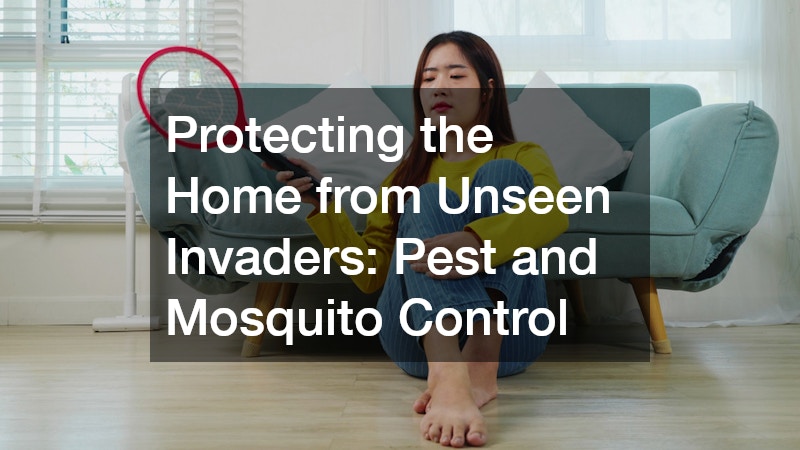
A. The Health Risks of Common Pests
Pests may be small, but the health threats they pose are serious. Cockroaches, rodents, and termites can carry diseases, trigger allergies, and damage property. Beyond being unsightly, these invaders can compromise a family’s comfort and well-being.
Hiring professional pest control services is essential to eliminate infestations safely. Experts use environmentally responsible methods to remove pests while preventing recurrence. Regular inspections—especially before rainy seasons—can stop infestations before they begin.
Preventive pest management doesn’t just protect the home; it also safeguards the family’s health by reducing exposure to droppings, bites, and bacteria that pests carry.
B. Preventing Vector-Borne Diseases Through Mosquito Management
Mosquitoes are another silent but dangerous invader. They carry diseases such as dengue, Zika, and West Nile virus, posing risks to both children and the elderly.
Working with a mosquito control company can help reduce mosquito populations around the home through targeted treatments and habitat management. They identify breeding areas—like stagnant water in gutters, flower pots, or backyard puddles—and use eco-safe solutions to prevent larvae from developing.
Families can further minimize risks by installing window screens, using repellents, and maintaining clean surroundings. The result: a home that’s both comfortable and disease-free.
Creating a Safe, Comfortable, and Inclusive Home Environment
A. Designing Spaces for Every Family Member’s Needs
Every family is unique, and their home should reflect that. A well-designed space accommodates people of all ages and abilities. Parents of children with disabilities, for example, may need specialized furniture or layouts that promote safety and independence.
One essential adaptation is the use of beds for kids with special needs. These beds provide proper support, prevent falls, and allow for adjustable comfort. Beyond functionality, they help children feel secure—creating an environment that promotes healing and confidence.
Lighting, flooring, and furniture placement should all be chosen with care to prevent accidents and ensure accessibility for everyone in the home.
B. Senior Comfort and Assisted Living at Home
Older adults often prefer the comfort of their own homes. However, as mobility decreases, the home must evolve to meet their needs. Integrating assisted living principles—such as wider doorways, non-slip surfaces, and handrails—can transform a standard home into a safe haven for seniors.
Families can also install motion-sensor lights or voice-activated devices to help older adults navigate safely at night. With these adjustments, seniors can maintain independence without compromising safety, reducing the need for institutional care while staying close to loved ones.
Building a Year-Round Family Maintenance Plan
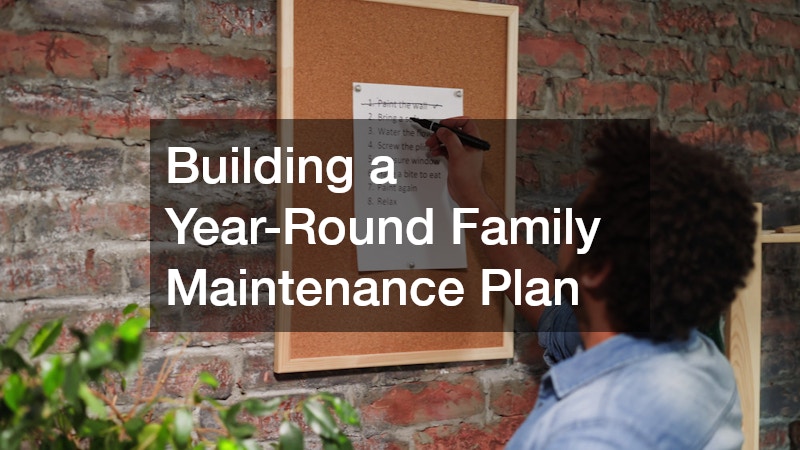
A. Coordinating Health and Home Care Schedules
Just like regular medical checkups, home maintenance requires a consistent schedule. Families who treat both as essential routines enjoy fewer emergencies and greater peace of mind.
A practical year-round plan could include:
-
Quarterly: Pest control and garbage disposal checks.
-
Biannually: HVAC maintenance and air filter replacement.
-
Annually: Water filtration inspections and roof or foundation assessments.
-
Seasonally: Deep cleaning sessions and mosquito control.
-
Monthly: Family health check-ins—reviewing doctor visits, vaccinations, and dietary needs.
Combining these tasks ensures every part of your home and health routine receives proper attention.
B. Budgeting for Family Health and Home Services
It’s easy to see medical care and home upkeep as separate expenses, but in reality, both protect the same asset—your family’s well-being. Setting aside a portion of the household budget for maintenance and healthcare prevents costly emergencies.
For instance, investing in an annual dental plan may prevent expensive root canals later. Likewise, scheduling routine HVAC inspections prevents energy waste and costly repairs. Allocating funds for preventive services pays off in long-term comfort and security.
Families who plan ahead and track their health and maintenance expenses tend to experience less stress and fewer financial surprises.
Professional Help vs. DIY: When to Call the Experts

A. Knowing When You Need Professional Services
While many home tasks can be handled through do-it-yourself methods, certain areas demand professional expertise to guarantee safety and effectiveness.
Here are a few examples of when to call in the pros:
-
Biohazard cleanup after contamination or accidents.
-
Specialized pest control to handle termites, bedbugs, or rodents.
-
Hiring an HVAC company for system cleaning, duct inspection, and repair.
-
Installation and maintenance of whole home water filtration systems.
-
Partnering with a mosquito control company for seasonal treatment programs.
These services use specialized tools, knowledge, and safety protocols that go beyond DIY capabilities.
B. Ensuring Quality and Safety in Professional Services
Choosing the right professionals makes all the difference. Families should look for licensed, insured, and experienced providers who follow strict health and safety standards. Reading reviews, checking references, and comparing quotes are all smart ways to ensure reliability.
High-quality service providers not only complete the job but also educate homeowners about preventive maintenance. For example, an HVAC technician may advise on filter replacement schedules, while a pest control expert might suggest home sealing techniques to prevent re-entry.
By viewing these professionals as partners in health, families create a stable and protective environment for everyone.
The Long-Term Payoff: A Holistic Approach to Family Health
Families who combine medical support with diligent home maintenance enjoy benefits that go far beyond physical health. They experience peace of mind, emotional stability, and stronger relationships. Clean air, pure water, pest-free surroundings, and reliable healthcare foster a lifestyle of comfort and trust.
This holistic approach also teaches children valuable lessons about responsibility, hygiene, and respect for their environment. When kids grow up in a home that values both medical wellness and maintenance, they’re more likely to carry those habits into adulthood.
A truly healthy household is one where everyone—from toddlers to grandparents—feels safe, supported, and valued. The payoff isn’t just a cleaner home; it’s a happier, more resilient family ready to face whatever challenges life brings.
Conclusion: Your Family’s Blueprint for Lifelong Wellness
In the end, creating a healthy family life is about balance—between the care we give our bodies and the care we give our homes. Regular medical checkups, quality pediatric services, and dental visits work hand in hand with essential home maintenance like pest prevention, water filtration, and waste management.
By bringing together the expertise of healthcare professionals and trusted home service providers, families can create an environment that nurtures both physical and emotional well-being. Whether through an HVAC company improving air quality, or garbage hauling services keeping the surroundings clean, every action contributes to the same goal: lasting health and comfort.
When we take a proactive approach to family care—combining medical support with clean, well-maintained spaces—we don’t just prevent problems; we build a legacy of wellness. This is the essence of a family care blueprint: a roadmap for nurturing health, safety, and happiness across generations.
Because in the end, there’s nothing more valuable than a happy and healthy family—one that thrives in a clean, safe, and loving home.

